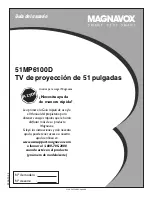
GLOSSARY
DLV 1280 User's Manual
A-5
The time required by the video amplifier of the projector to increase its output
from 10% to 90% of the maximum value.
The video output (analog or digital) of most computers. Analog RGB video can
have 3, 4, or 5 wires — one each for red, green, and blue, and either none, one or
two for sync. For three-wire RGB, the green wire usually provides sync. (See
TTL Video).
An asynchronous data transmission standard recommended by the Electronics
Industries Association (EIA). Also called serial communication.
The output from certain video tape players and video equipment. S-Video
separates sync and luminance from color information, typically producing a
higher quality display than composite video.
The horizontal or vertical frequency at which images are generated.
One horizontal line on the display.
A video output format of some video tape and disk players (used primarily in
France). SECAM (Sequential Couleur á Mémoire) signals are similar in
resolution and frequency to PAL signals. The primary difference between the
two standards is in the way color information is encoded.
A slidebar is a graphical display of an adjustable setting. The numerical setting
usually represents a percentage.
The device, such as a computer or VCR, connected to the projector for display.
A source is identified by the projector as
,
,
or
, or as
other user-defined numbers. Sources have corresponding channels recognized by
the projector.
See channel.
The diameter of the smallest dot that can be generated by a CRT projector.
A signal selector that can be connected to a projector for the purpose of adding
more sources.
This term refers to the part of the video signal that is used to stabilize the picture.
Sync can occur in three forms:
1)
"Composite sync": the horizontal and vertical components are together on
one cable.
2)
"Sync-on-green": the sync is part of the green video.
3)
"Separate sync" or "H.SYNC and V.SYNC": the horizontal and vertical
components of the sync are on two separate cables.
The duration of each sync pulse generated by a computer. The sync width is part
of the blanking time.
A type of RGB video with digital characteristics.
A wire connecting a single video source to a display device, such as a projector,
must be terminated by a resistance (usually 75
S for video).
Rise Time
'
RGB Video
'
RS-232
'
S-Video
'
Scan Frequency
'
Scan Line
'
SECAM
'
Slidebar
'
Source
'
Source Setup
'
Spot Size
'
Switcher
'
Sync
'
Sync Width
'
TTL Video
'
Terminated
'














































